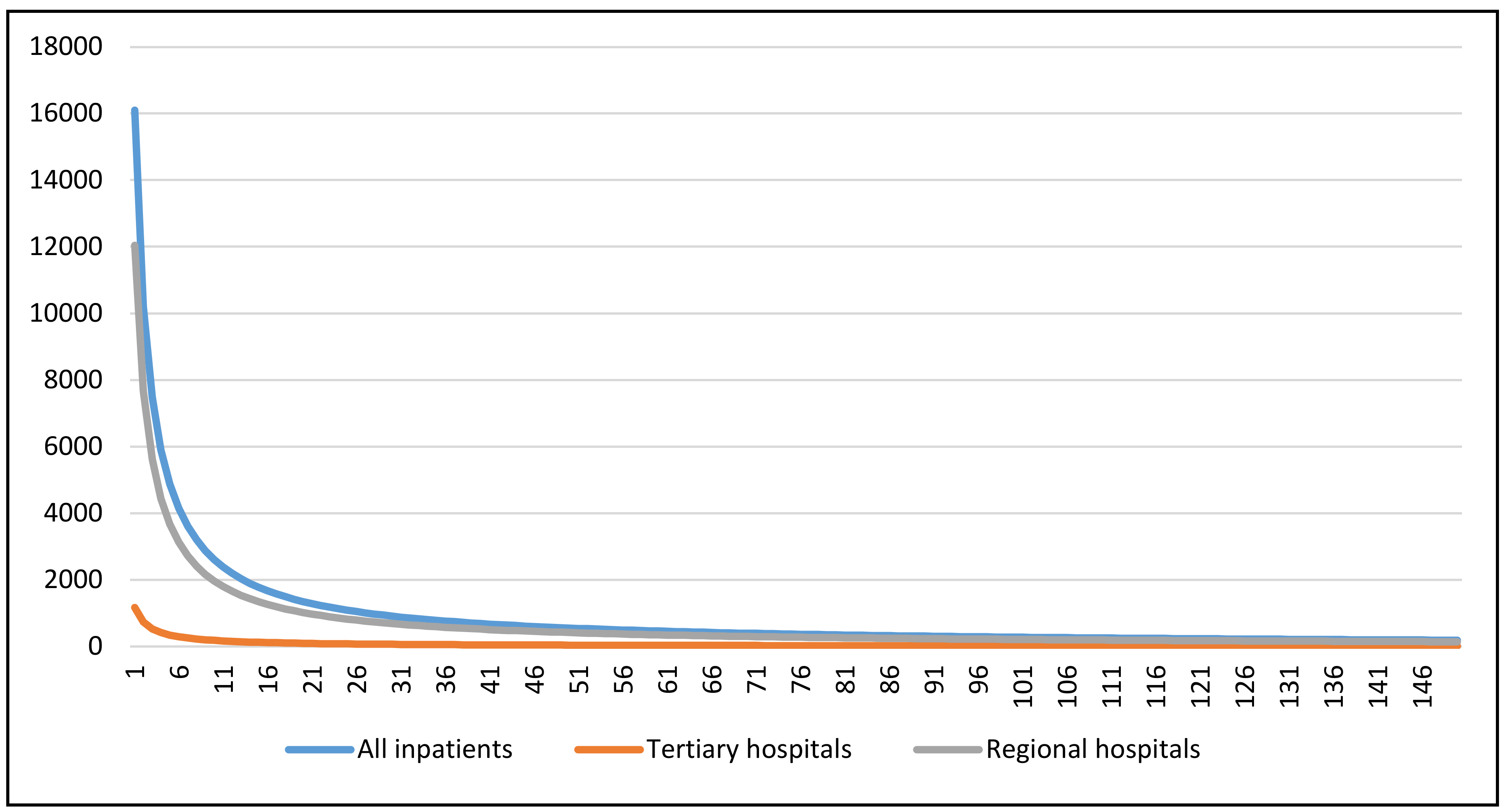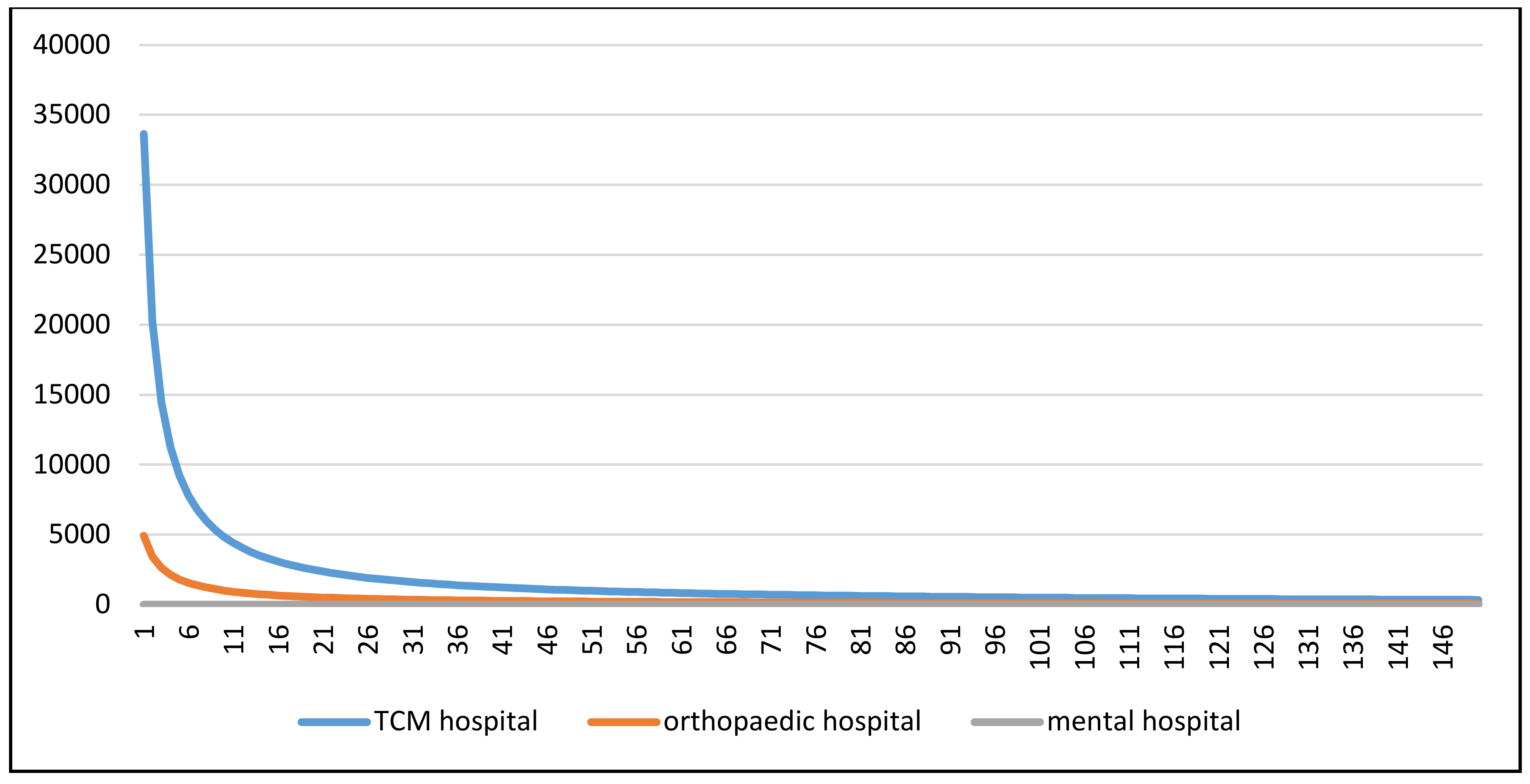Inpatient Flow Distribution Patterns at Shanghai Hospitals
Abstract
1. Background
1.1. Shanghai Medical Service System
1.2. Quantitative Model for Descripting Patient Flow
2. Method
2.1. Data Sources and Processing
2.1.1. Population Data
2.1.2. Inpatient Flow Data
2.1.3. Hospital Information
2.2. Modeling Hospital Visits by Gravity Model
2.2.1. Identify Demographic Units
2.2.2. Establishment of the Patient Distribution Flow Analysis Database
- (1)
- Establish the inpatient flow database (). First, according to the home address information of inpatients in the inpatient database, the spatial locations of the inpatients were identified. Second, with the help of geographic information systems, the spatial relationship between the patient’s home address and geographic unit was calculated. Then, the number of patients accepted by each medical institution in each geographic unit were summarized and counted.
- (2)
- Count the population in each geographic unit (). According to the spatial relationship between residential sites and geographical units, the resident population of each geographical unit was calculated.
- (3)
- Calculate the distance matrix between each geographic unit and each hospital (). First, each medical institution was given a unique identification code. Second, traffic road information was superimposed, and the road network distance between each geographic unit and medical institution was calculated by using ArcGIS to form the distance matrix of geographical units (i) and medical institutions (j).
- (4)
- Add the population information from step 2 () to the inpatient flow database (). The unique identifier of the geographic units was used as the connection field to add the geographic unit population information attributed to the inpatient flow database.
- (5)
- Add the distance information from step 3 () to the inpatient flow database (). The geographic unit and the hospital unique identifiers were used as connection fields to add the distance attribute between the geographic units and the hospitals to the inpatient flow database.
- (6)
- Add the hospital bed information () to the inpatient flow database (). The unique hospital identification code was used as a connection field to add attributes, such as the number of beds from the hospital database, to the inpatient flow database.
2.2.3. Nonlinear Fitting of Inpatient Flow Patterns
3. Results
4. Discussion
5. Conclusions
Author Contributions
Funding
Acknowledgments
Conflicts of Interest
References
- National Health Commission of the People’s Republic of China. China Health Statistics Yearbook 2019 [DB/OL]. Available online: http://www.shujuku.org/china-health-statistical-yearbook.html (accessed on 31 January 2020).
- Shanghai Municipal Development & Reform Commission. Shanghai’s 13th Five-Year Plan for Health and Family Planning Reform and Development [EB/OL]. Available online: http://fgw.sh.gov.cn/fzgggz/sswgg/ggwbhwgwj/27709.htm (accessed on 31 January 2020).
- OECD. Health Spending (Indicator); OECD: Paris, France, 2020; Available online: https://data.oecd.org/healthres/health-spending.htm (accessed on 31 January 2020). [CrossRef]
- General Office of the State Council of the People’s Republic of China. Guiding on Promoting the Construction of Hierarchical Medical System [EB/OL]. Available online: http://www.gov.cn/zhengce/content/2015-09/11/content_10158.htm (accessed on 31 January 2020).
- Jia, P.; Wang, F.; Xierali, I.M. Delineating Hierarchical Hospital Service Areas in Florida. Geogr. Rev. 2017, 107, 608–623. [Google Scholar] [CrossRef]
- Jia, P.; Wang, F.; Xierali, I.M. Differential effects of distance decay on hospital inpatient visits among subpopulations in Florida, USA. Environ. Monit. Assess. 2019, 191 (Suppl. 2), 381. [Google Scholar] [CrossRef]
- Xiong, X.; Jin, C.; Chen, H.; Luo, L. Using the Fusion Proximal Area Method and Gravity Method to Identify Areas with Physician Shortages. PLoS ONE 2016, 11, e0163504. [Google Scholar] [CrossRef]
- Wang, F. Measurement, optimization, and impact of health care accessibility: A methodological review. Ann. Assoc. Am. Geogr. Assoc. Am. Geogr. 2012, 102, 1104–1112. [Google Scholar] [CrossRef] [PubMed]
- Radcliff, T.A.; Brasure, M.; Moscovice, I.S.; Stensland, J.T. Understanding rural hospital bypass behavior. J. Rural Health Off. J. Am. Rural Health Assoc. Natl. Rural Health Care Assoc. 2003, 19, 252–259. [Google Scholar] [CrossRef] [PubMed]
- Hodgson, M.J. An hierarchical location-allocation model for primary health care delivery in a developing area. Soc. Sci. Med. 1988, 26, 153–161. [Google Scholar] [CrossRef]
- Propper, C.; Damiani, M.; Leckie, G.; Dixon, J. Impact of patients’ socioeconomic status on the distance travelled for hospital admission in the English National Health Service. J. Health Serv. Res. Policy 2007, 12, 153–159. [Google Scholar] [CrossRef] [PubMed]
- Link, B.G.; Phelan, J. Social conditions as fundamental causes of disease. J. Health Soc. Behav. 1995, 80–94. [Google Scholar] [CrossRef]
- Wang, F.; Xu, Y. Estimating O-D travel time matrix by Google Maps API: Implementation, advantages and implications. Annals GIS 2011, 17, 199–209. [Google Scholar] [CrossRef]
- Wang, F. Quantitative Methods and Social-Economic Application in GIS, 2nd ed.; CRC Press: Boca Raton, FL, USA, 2015. [Google Scholar]
- Guagliardo, M.F. Spatial accessibility of primary care: Concepts, methods and challenges. Int. J. Health Geogr. 2004, 3, 3. [Google Scholar] [CrossRef] [PubMed]
- Delamater, P.L.; Messina, J.P.; Grady, S.C.; WinklerPrins, V.; Shortridge, A.M. Do more hospital beds lead to higher hospitalization rates? a spatial examination of Roemer’s law. PLoS ONE 2013, 8, e54900. [Google Scholar] [CrossRef] [PubMed]
- Arcury, T.A.; Gesler, W.M.; Preisser, J.S.; Sherman, J.; Spencer, J.; Perin, J. The Effects of Geography and Spatial Behavior on Health Care Utilization among the Residents of a Rural Region. Health Serv. Res. 2005, 40, 135–155. [Google Scholar] [CrossRef] [PubMed]
- Jia, P.; Wang, F.; Xierali, I.M. Using a Huff-Based Model to Delineate Hospital Service Areas. Prof. Geogr. 2017, 69, 522–530. [Google Scholar] [CrossRef]
- Reilly, W.J. The Law of Retail Gravitation. Am. J. Sociol. 1932, 37, 826–828. [Google Scholar]
- Guercini, S.; Ranfagni, S. Cognitive source and clothing retail. J. Fash. Mark. Manag. 2007, 11, 398–412. [Google Scholar] [CrossRef]
- Mira, J.J.; Lorenzo, S.; Navarro, I. Hospital Reputation and Perceptions of Patient Safety. Med Princ. Pract. 2014, 23, 92–94. [Google Scholar] [CrossRef] [PubMed]
- Huff, D.L. Defining and estimating a trading area. J. Mark. 1964, 28, 34–38. [Google Scholar] [CrossRef]


| Distance Decay Functions | Formula | Formula |
|---|---|---|
| Power function | ||
| Negative exponential function | ||
| Gaussian function | ||
| Log-logistic function |
| Hospital Type | No. Inpatients | Formula f(dij) | Parameters | Model Assessment | ||||||
|---|---|---|---|---|---|---|---|---|---|---|
| μ | α | σ | θ | β | P | R2 | AIC | |||
| All inpatients | 2524709 | Power | 0.00116 | 0.5572 | 1.0605 | - | 0.78 | <0.0001 | 16.07 | 7050593 |
| Exponential | 0.0918 | 0.4117 | 0.7899 | - | 0.4669 | <0.0001 | 20.34 | 6993253 | ||
| Gaussian | 0.0469 | 0.4506 | 0.7767 | 2.0439 | - | <0.0001 | 18.41 | 7019565 | ||
| Log-logistic | 0.1206 | 0.3991 | 0.7901 | 1.2256 | 1.6696 | <0.0001 | 21.61 | 6975704 | ||
| Tertiary hospitals | 966405 | Power | 0.000152 | 0.9266 | 0.828 | - | 0.9452 | <0.0001 | 19.31 | 2795705 |
| Exponential | 0.00374 | 0.7035 | 0.7766 | - | 0.3933 | <0.0001 | 18.81 | 2798303 | ||
| Gaussian | 0.00141 | 0.7412 | 0.7935 | 2.6672 | - | <0.0001 | 16.71 | 2808981 | ||
| Log-logistic | 0.0055 | 0.7250 | 0.7602 | 0.888 | 1.4046 | <0.0001 | 20.21 | 2790959 | ||
| Regional hospitals | 1558304 | Power | 0.0104 | 0.2940 | 1.1436 | - | 0.7456 | <0.0001 | 15.77 | 4209599 |
| Exponential | 0.0674 | 0.3758 | 0.9265 | - | 0.5245 | <0.0001 | 22.82 | 4150433 | ||
| Gaussian | 0.0299 | 0.4257 | 0.9251 | 1.7796 | - | <0.0001 | 21.37 | 4163078 | ||
| Log-logistic | 0.0874 | 0.3483 | 0.9222 | 1.4221 | 1.8920 | <0.0001 | 23.97 | 4140329 | ||
| TCM hospital | 313983 | Power | 0.00391 | 0.4808 | 1.0125 | 0.7580 | <0.0001 | 41.50 | 726665 | |
| Exponential | 0.2610 | 0.3481 | 0.8133 | 0.7009 | <0.0001 | 52.97 | 696918 | |||
| Gaussian | 0.2464 | 0.3446 | 0.7837 | 1.2839 | <0.0001 | 48.73 | 708687 | |||
| Log-logistic | 0.3884 | 0.3093 | 0.8311 | 0.8315 | 1.6358 | <0.0001 | 57.35 | 745253 | ||
| Orthopedic hospital | 1715 | Power | 0.1647 | 0.3108 | 0.2 | 0.4234 | <0.0001 | 22.53 | 1983 | |
| Exponential | 0.0113 | 0.6089 | 0.1791 | 0.1229 | <0.0001 | 21.9 | 1989 | |||
| Gaussian | 0.00963 | 0.5427 | 0.2617 | 9.3228 | <0.0001 | 19.74 | 2009 | |||
| Log-logistic | 0.2284 | 0.4228 | 0.0903 | 1.1018 | 0.848 | <0.0001 | 23.82 | 1970 | ||
| Mental hospital | 9209 | Power | 0.000003054 | 0.9505 | 0.8436 | 0.3335 | <0.0001 | 38.56 | 8473 | |
| Exponential | 0.000009653 | 0.8663 | 0.8047 | 0.0729 | <0.0001 | 39.29 | 8425 | |||
| Gaussian | 0.000004937 | 0.9082 | 0.7909 | 12.341 | <0.0001 | 37.64 | 8532 | |||
| Log-logistic | 0.000015 | 0.8653 | 0.8209 | 3.0989 | 0.8531 | <0.0001 | 40.19 | 8365 | ||
| Tumor hospital | 23486 | Power | 0.00373 | 0.5441 | 0.6464 | - | 0.4581 | <0.0001 | 2.58 | 67072 |
| Exponential | 0.1074 | 0.1602 | 0.7724 | - | 0.1290 | <0.0001 | 2.82 | 67047 | ||
| Gaussian | 0.0774 | 0.0715 | 0.9204 | 6.8460 | <0.0001 | 2.86 | 67043 | |||
| Log-logistic | ||||||||||
| Children’s Hospital | 55000 | Power | 2.3227 | 0.3625 | 0.0575 | 0.7137 | <0.0001 | 0.83 | 192687 | |
| Exponential | 5.5942 | 0.2269 | 0.1188 | 0.1339 | <0.0001 | 0.98 | 192651 | |||
| Gaussian | 4.1994 | 0.2065 | 0.1516 | 7.1108 | <0.0001 | 1.04 | 192639 | |||
| Log-logistic | ||||||||||
| Maternity hospital | 37976 | Power | 0.000658 | −0.3234 | 2.9667 | 1.3515 | <0.0001 | 2.43 | 152093 | |
| Exponential | 0.000485 | −0.5219 | 3.6051 | 0.7271 | <0.0001 | 5.98 | 151481 | |||
| Gaussian | 2.15E-11 | −3.1238 | 11.412 | 0.7316 | <0.0001 | 13.81 | 150048 | |||
| Log-logistic | ||||||||||
| Hospital Type | β | Tij |
|---|---|---|
| All | 1.67 | |
| Tertiary hospitals | 1.40 | |
| Regional hospitals | 1.89 | |
| TCM hospital | 1.64 | |
| Orthopedic hospital | 0.85 | |
| Mental hospital | 0.85 |
© 2020 by the authors. Licensee MDPI, Basel, Switzerland. This article is an open access article distributed under the terms and conditions of the Creative Commons Attribution (CC BY) license (http://creativecommons.org/licenses/by/4.0/).
Share and Cite
Xiong, X.; Luo, L. Inpatient Flow Distribution Patterns at Shanghai Hospitals. Int. J. Environ. Res. Public Health 2020, 17, 2183. https://doi.org/10.3390/ijerph17072183
Xiong X, Luo L. Inpatient Flow Distribution Patterns at Shanghai Hospitals. International Journal of Environmental Research and Public Health. 2020; 17(7):2183. https://doi.org/10.3390/ijerph17072183
Chicago/Turabian StyleXiong, Xuechen, and Li Luo. 2020. "Inpatient Flow Distribution Patterns at Shanghai Hospitals" International Journal of Environmental Research and Public Health 17, no. 7: 2183. https://doi.org/10.3390/ijerph17072183
APA StyleXiong, X., & Luo, L. (2020). Inpatient Flow Distribution Patterns at Shanghai Hospitals. International Journal of Environmental Research and Public Health, 17(7), 2183. https://doi.org/10.3390/ijerph17072183




